In the Slick of It: Art and the Oil Industry in New Orleans
Ann Hackett explores the questions some artists and arts organizations in New Orleans are asking themselves about their relationships to the oil industry.
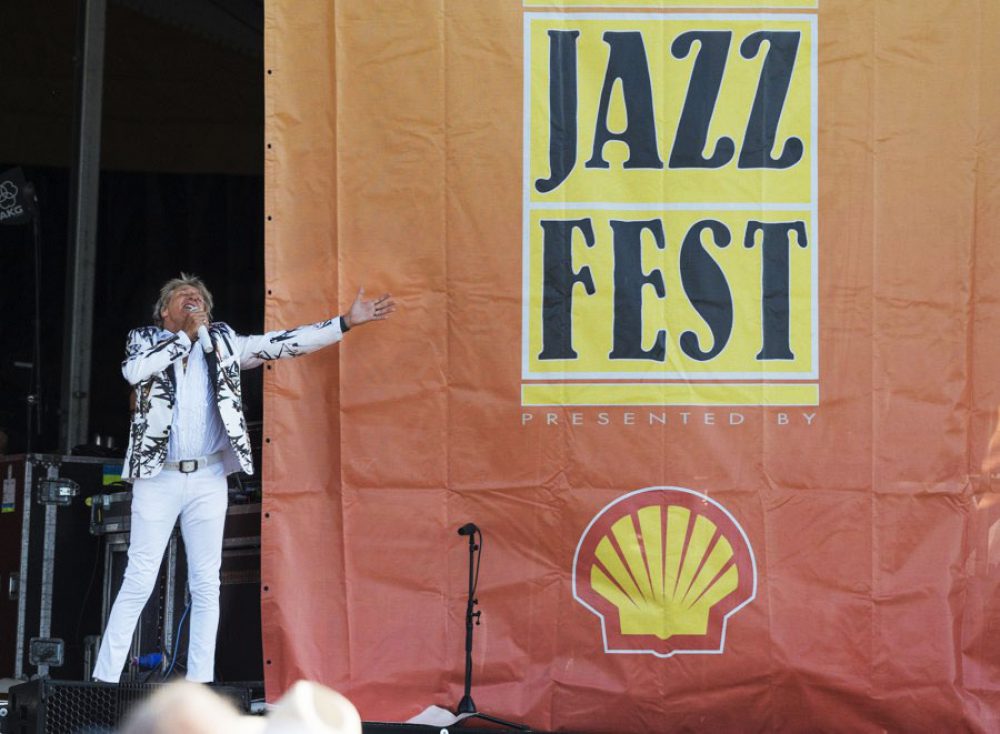
Rod Stewart performing on the Acura Stage at New Orleans Jazz & Heritage Festival on April 28, 2018. Photo via The Gambit.
It’s festival season in New Orleans, and one group we have to thank is the oil and gas industry. But that’s not all we should thank them for. We should thank them for the tricentennial celebration, the Ogden Museum of Southern Art, the Contemporary Arts Center, the New Orleans Museum of Art, the Louisiana State Museum, the Audubon Zoo and Aquarium of the Americas, the National WWII Museum, the New Orleans Botanical Garden, the New Orleans Center for Creative Arts, The Historic New Orleans Collection, Prospect New Orleans, City Park, and many more of the city’s cultural institutions. They all receive significant funding from companies making money from the Gulf’s oil and gas industry or from foundations funded by this wealth.
From 1958 to 2007, cigarette manufacturer Philip Morris funded a lot of arts organizations, including the Whitney Museum of American Art in New York. (In 1990 alone, the company contributed around $15 million to arts organizations across the country.) After years of backlash, the partnership between tobacco and the arts is largely over. Over the past few years, other corporate interests have begun to come under fire. The Metropolitan Museum of Art has faced protests against its Sackler Wing (the Sackler family, owners of Purdue Pharmaceuticals, made millions from OxyContin) and its David H. Koch Plaza (according to a flyer from activist group Occupy Museums, “Koch Industries is the largest funder of climate science denying organizations in the world”). In London, artists and activists Liberate Tate successfully pressured Tate Modern into ceasing its relationship with BP (formerly British Petroleum).
Over the last century oil and gas has employed generations of Louisianans. (Currently 45,000 people in Louisiana make their living working in the oil and gas industry.) Historically this has provided oil and gas companies with a sense of public goodwill. But as climate-change disasters continue to mount, killing people and destroying property, fossil-fuel industries—like cigarette companies—are losing what’s left of that goodwill. In 2013, the Southeast Louisiana Flood Protection Authority-East filed a lawsuit naming 97 oil and gas companies as culpable for environmental damages caused by their operations. Since then six parishes—St. John the Baptist, St. Bernard, Plaquemines, Vermilion, Cameron, and Jefferson—have filed over 40 lawsuits against the oil and gas industry, calling out Helis Oil & Gas Energy Project, Shell Oil Company, ExxonMobil, and Chevron Corporation, among many others. After watching the coastline melt away into the Gulf of Mexico and experiencing the devastation wrought by Hurricanes Katrina and Rita and the Deepwater Horizon explosion and oil spill, a lot of people are changing their minds—notably not the Trump administration, who held a sale this spring attempting to lease every available offshore drilling site in the Gulf of Mexico to oil and gas companies.
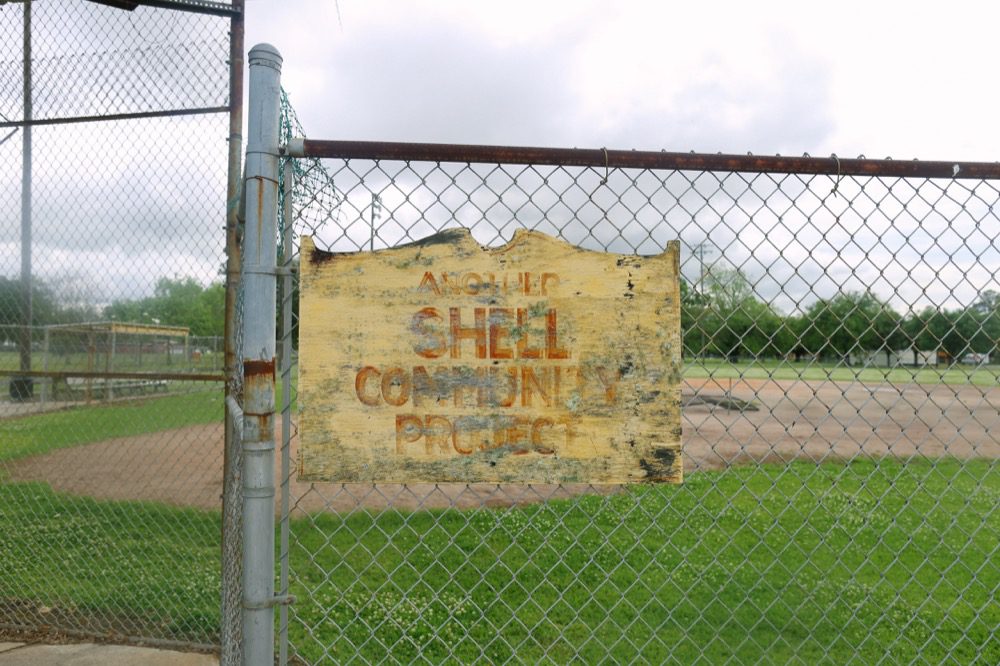
During Fossil Free Fest, Hidden History Tours and the Louisiana Bucket Brigade took visitors to Norco, Louisiana, on an environmental-justice tour. Courtesy Fossil Free Fest. Photo by Patrick Melon.
It’s not a new story. It’s not a secret. New Orleans arts workers know that all of the city’s major institutions are heavily supported by oil- and gas-endowed foundations and corporations. The Helis Foundation, for example, is funded by the family who started the Helis Oil & Gas Energy Project. An old-school oil baron, William Helis made a fortune drilling Louisiana oil in the 1930s. After his death in 1950, his family established the Helis Foundation. The foundation is particularly interested in visual arts. In addition to many other projects, they sponsor the city’s two major juried exhibitions for New Orleans and Louisiana artists, the Ogden’s “Louisiana Contemporary” and the Contemporary Arts Center’s annual open call. In 2015, the Ogden took over $380,000 from Helis, 10% of the museum’s total revenue for that year. The head curator at the CAC, a position currently held by Andrea Andersson, is called the Helis Foundation Curator for Contemporary Art.
Wells drilled by Taylor Energy’s Mississippi Canyon 20-A platform have been leaking oil into the Gulf for 14 years, a fact that Taylor covered up, and since they have no plan to cap the wells, the leak may continue for the next 100 years. At the same time, the Taylor Foundation funds the WWII Museum, the Louisiana State Museum, and the Louisiana Children’s Museum. The Historic New Orleans Collection, the engine behind much of the tricentennial celebration, is funded almost entirely by the Kemper and Leila Williams Foundation, which, in addition to being another oil-family foundation, continues to own and lease mineral rights for drilling; the foundation made $566,076 in royalties from those leases in 2017. After Katrina, Shell swooped in to save Jazz Fest. Chevron sponsors French Quarter Fest. The list goes on.
These corporate-affiliated foundations may pose as independent operations from their parent companies, but they are undoubtedly public-relations machines. This became especially obvious when Entergy, facing protests over its proposed power plant in New Orleans East, withdrew $20,000 in funding from WBOK after the radio station reported on these protests.
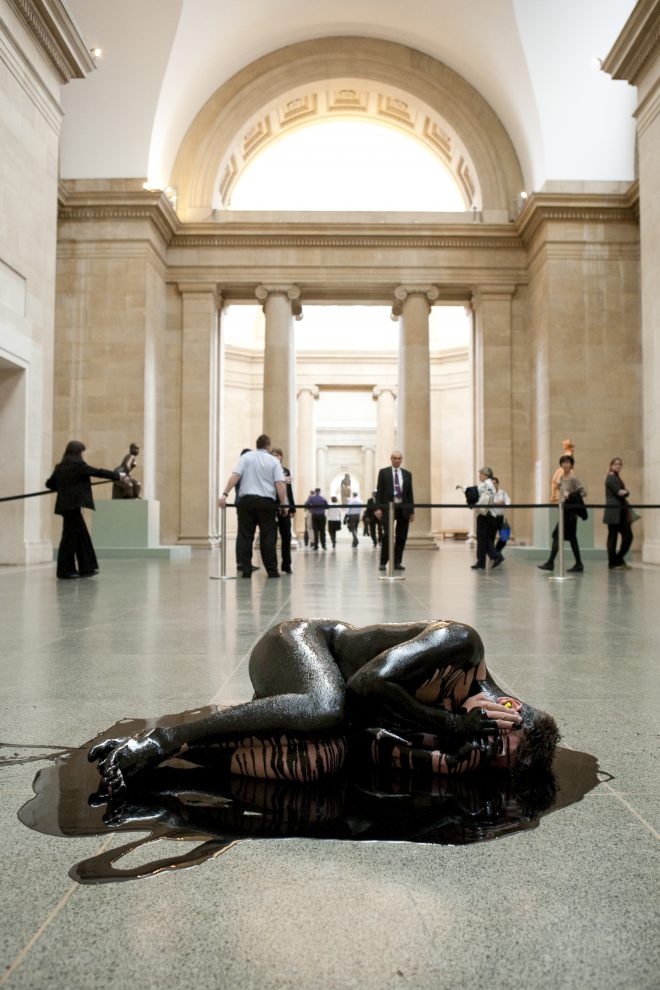
Liberate Tate’s performance Human Cost, 2011, at Tate Britain, London. Courtesy the artist.
If oil and gas is willing to dump millions into festivals, museums, and schools, why do they fight so hard against paying for the damage they’ve done to the wetlands? One reason is that it would cost a lot more money to fix the problems they’ve created or contributed to than to fund an exhibition or festival that increases their public profile. The Southeast Louisiana Flood Protection Authority-East’s 2013 lawsuit requested damages totalling $90 billion, the estimated cost of the Coastal Master Plan. The companies responded by successfully lobbying Baton Rouge to pass a law that would make the suit illegal.
The other answer is that paying damages establishes a dangerous precedent of admitting that the oil companies know that they are endangering the coastline when they drill canals in coastal marshes and neglect to fill them in. By their own estimate, the industry is responsible for 36% of coastal land loss. Other estimates range between 15 and 90%.
“Fossil fuels” should be a dirty phrase among arts institutions, but it isn’t. This April, a coalition of artists, arts workers, and activists came together to try and change that at the first New Orleans Fossil Free Fest, presented by Antenna. The festival included panels, speeches, and workshops arranged around three themes—equity, complicity, and vision to action. The overall goal was to imagine ways to keep fossil-fuel funding out of the arts.
The city’s most iconic fest, New Orleans Jazz & Heritage Festival, imagines itself to be a celebration of music, arts, and food, exporting Louisiana culture to the world through the tourists who attend. Fossil Free Fest imitated that model on a small scale by including music by local bands; visual art; four days of film screenings; performances; storytelling; poetry readings; and food. Events took place at the Joan Mitchell Center and Grow Dat Youth Farm. Participating artists included Hannah Chalew, Quintron and Miss Pussycat, Sunni Patterson, ArtSpot Productions, Mondo Bizarro’s Loup Garou, and many others. The Fest was organized by Imani Jacqueline Brown, Monique Verdin, Raquel de Anda, Katie Mathews, and Jayeesha Dutta.
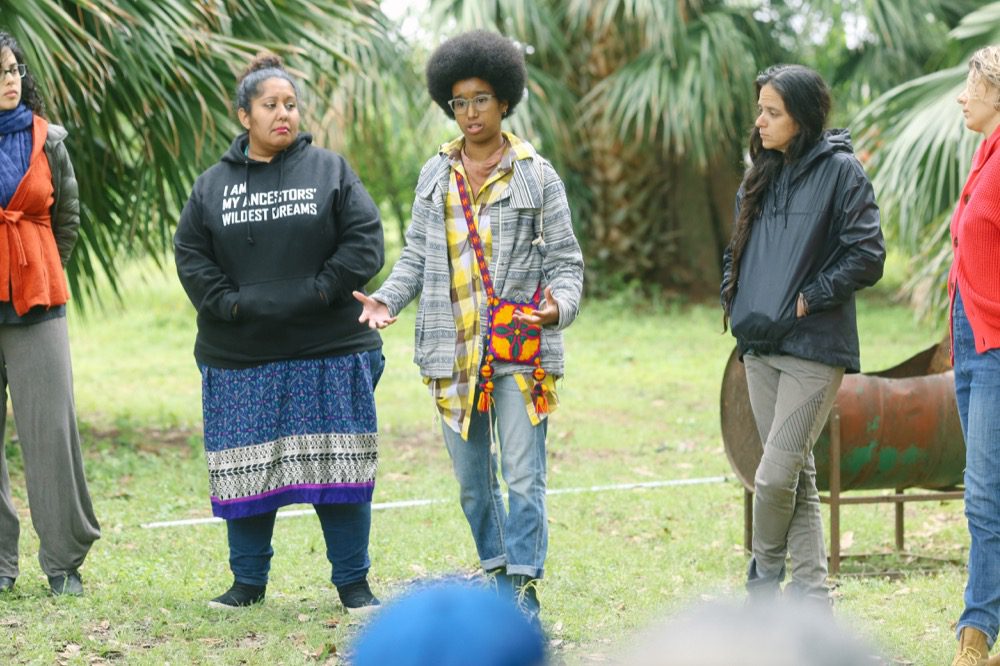
Organizers Jayeesha Dutta, Imani Jacqueline Brown, and Monique Verdin at Fossil Free Fest in New Orleans. Courtesy Fossil Free Fest. Photo by Patrick Melon.
New Orleans native Brown is the woman who brought all of these people and organizations together. She is an arts worker and an activist. (Brown is currently Director of Programs at Antenna and is also a member of Occupy Museums, which led protests at the Met’s Koch Plaza, and a contributor to Pelican Bomb’s Art Review.)
As Brown welcomed people to the festival, she described visiting the Audubon Aquarium on Canal Street. In the aquarium’s largest display, the Gulf of Mexico exhibit, among the sea turtles, sharks, rays, and schools of fish, she noticed a quarter-sized model of a derelict, offshore oil rig. The wall text reads:
The Gulf of Mexico has been home to oil rigs for decades. Energy companies are an important part of the culture and infrastructure in South Louisiana, employing thousands of people and contributing to the state’s economy. In addition to being active community partners, energy companies participate in the “Rigs to Reefs” program, leaving their rigs in place, when feasible, to serve as substructure on which reef systems develop. These reefs provide food, shelter, and protection to animals that live within and around the rigs, from the smallest fish to apex predators like sharks.
Next to the wall text are the logos of the exhibit’s sponsors including BP, Shell, ExxonMobil, Chevron, Kerr-McGee, and Tenneco. This exhibit, installed in 1990 when the Aquarium opened, is a rare New Orleans example of blatant oil-industry marketing within a public museum. It is devoted to Louisiana oil and gas, including a separate sign, informing visitors about “Louisiana’s Offshore Riches.” Throughout the Aquarium’s Louisiana-related exhibits, there’s information about man-made coastal land loss, variously blaming levee-building, nutria, exotic plant species, among other things. One group that is conspicuously absent: Louisiana oil and gas.
What shocked Brown the most was that she never saw the rig as a child going to the Aquarium. She didn’t notice it because she was conditioned not to. Back then she didn’t know the dangers of oil extraction, but now, after having returned to the city after evacuating during Hurricane Katrina and seeing Louisiana lose 2000 miles of coastline, she can see the oil rig.

The Gulf of Mexico display at the Audubon Aquarium of the Americas, New Orleans. Photo by the author.
Even though fossil-fuel consumption is deeply entrenched in our global consumer culture, fossil-fuel companies also need a social license to extract and process fossil fuels, and the conditioning of children with exhibits like the Gulf of Mexico tank are part of how they get that license. In a 2012 speech to oil-industry insiders, BP Executive Vice President Dev Sanyal described the social license to operate as “a metaphorical concept. It indicates that companies cannot operate sustainably without the support of society.” It’s time to revoke it, Brown said in her Fossil Fuel Fest welcome address.
After Brown’s speech, environmental lawyer Monique Harden talked about Entergy’s proposal to build a 128-megawatt natural-gas power plant in New Orleans East that will, according to Harden, release over two million pounds of toxic pollution and over one billion tons of greenhouse gas emissions. Harden called out the “real palpable racism that we have in New Orleans about New Orleans East,” which allowed the city council to approve the plant without “any payback” from other council districts. This power-plant proposal became a national scandal when The Lens discovered that Entergy had hired actors to appear at council meetings in support of the proposed plant. Harden’s Deep South Center for Environmental Justice and other organizations have now filed a lawsuit contesting the vote.
This is not the first time City Council has tried to push industry on New Orleans East, which has a largely non-white population and more undeveloped land than the other districts. They also approved a plan to lease 281 acres of wetlands to the Port of New Orleans for industrial development and a plan to zone business parks for industrial use, eventually struck down due to pressure from the community. Harden’s speech introduced one of the dominant themes of the festival: how fossil-fuel companies victimize communities of color, either by singling them out for sites of industry (with industry comes pollution) or by taking their land for oil extraction or transport, and the widespread racism, on the part of elected representatives and the public, that allows this process to continue. The festival highlighted several works exposing this practice.
One of these works was artist Monique Verdin and director Sharon Linezo Hong’s documentary film My Louisiana Love (2012). The film’s story begins in the early 1900s when oil companies dispossessed Verdin’s family, members of the United Houma Nation, of their Gulf Coast land using contracts written in English, which was at that time a foreign language for the Houma. Hurricane Katrina hit 100 years later, and the Mississippi River-Gulf Outlet Canal broke its banks and destroyed the town in St. Bernard where Verdin’s grandmother now lives.
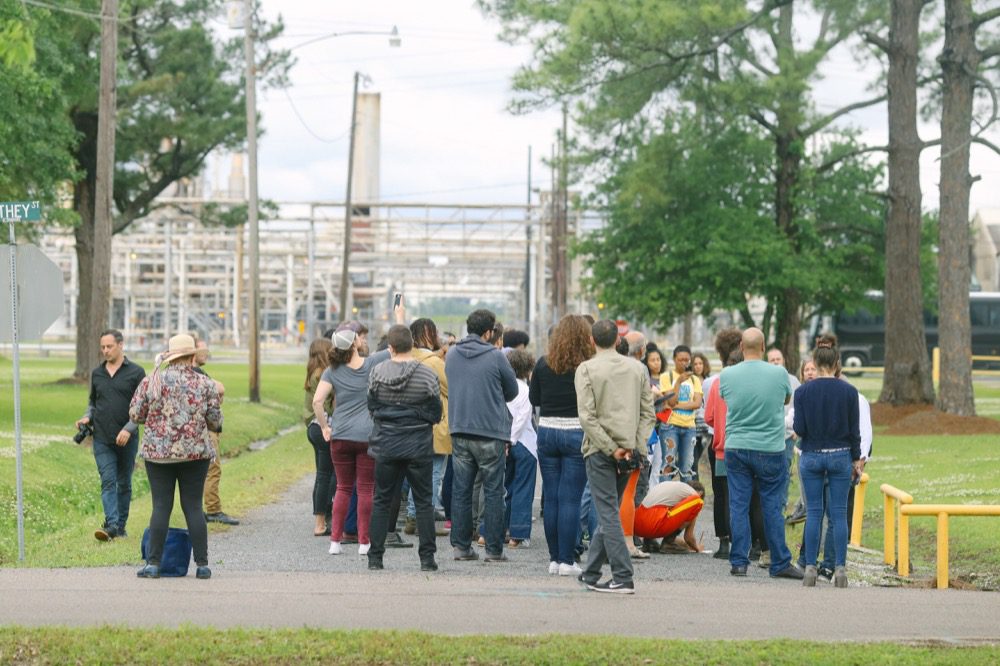
During Fossil Free Fest, Hidden History Tours and the Louisiana Bucket Brigade took visitors on an environmental-justice tour. They visited the Diamond neighborhood of Norco, Louisiana, directly adjacent to the W.R. Grace & Co. chemical plant. Courtesy Fossil Free Fest. Photo by Patrick Melon.
Organizer Katie Mathews presented a preview of Mossville, a documentary by Alex Glustrom, director of Big Charity (2014), and produced by Matthews and Daniel Bennett. Mossville is an African-American community near Lake Charles, founded by free people of color. The town is currently surrounded by 14 petrochemical plants. One more wants to move in and level the entire town. The film follows the last hold out, Stacey Ryan, as he fights to keep his ancestral home while Sasol—formerly an arm of the South African apartheid government—builds a chemical plant just outside the limits of his property. All around him, people are moving out or are sick and dying from chemical exposure.
Mossville is a several-hour drive from New Orleans, but there are sites of petrochemical pollution just half an hour away at the southern end of what is called Cancer Alley, a string of industrial plants between New Orleans and Baton Rouge. One morning festival-goers boarded buses headed for the town of Norco, Louisiana, with Leon Waters of Hidden History Tours and Anne Rolfes of the Louisiana Bucket Brigade. (The Bucket Brigade gives devices, “buckets,” that measure air quality to people who live adjacent to petrochemical plants.)
In the 1910s, Shell bought land in the town of Sellers, Louisiana, and built an oil refinery, changing the town’s name in the 1920s to Norco, short for “New Orleans Refining Company.” In the last 100 years, industry has taken over Norco. Several different companies now operate, many of them in facilities originally built by Shell. Norco now sits between the Mississippi River and Bonnet Carré Spillway, between the Valero St. Charles Refinery, Shell Chemical, and W.R. Grace & Co. plants, with Dow Chemical, Arkema, Galata Chemicals, and the Occidental Chemical Corporation directly across the river.
When we stepped off the bus in Diamond, a neighborhood of Norco, the air smelled metallic. The W.R. Grace & Co. plant, a maze of white painted piping leading to and from massive spherical and columnar tanks, stood in front of us. All around were empty lots. These empty lots represent a double-edged victory for Diamond’s predominantly African-American residents, who endured years of deadly chemical exposure and industrial accidents before Shell agreed to buy out their properties in 2002.
“A pyrrhic victory,” Rolfes said because some of these families had lived in Norco since the 1800s. Some of their ancestors were enslaved on the surrounding German Coast plantations. Community organizer Margie Richards, leader of the fight against Shell, put it this way, “If my ancestors can stand up to slavery, I can stand up to Shell.”
The Slave Revolt of 1811 ended near the location where we were standing with the killing and capture of most of the insurgents. Talking or writing about resistance to slavery was illegal at the time, so this revolt, our nation’s largest, was almost forgotten. Our tour guide Waters pointed across the spillway and recounted an unsuccessful petition submitted by himself and other community members to local government requesting permission to section off two unmarked gravesites of over 300 enslaved people. Waters believes it would have put a wrench into plans for future factories. (In Ascension Parish, Shell discovered the graves of over 1000 enslaved people outside of its Convent Refinery and has plans to mark the cemeteries.)
Waters’ point in linking these two parts of history is not that petrochemical companies are the same as slave owners or the governments that propped up slavery, but that petrochemical companies use racism to their advantage. They treat their host communities as if their lives are worth nothing, based on a calculus that suggests that here in Louisiana most elected officials and most of the public won’t care as long as factories stay out of wealthy white communities.
Local and state government prize industry above people’s health and their lives. The Louisiana industrial tax exemption, the nation’s largest, allows these factories to apply for exemptions every 10 or 25 years, with infinite renewal. Considering the billions of dollars that Louisiana industry has not paid in state taxes, it’s no surprise that Louisiana is consistently last or next to last in education, health services, and infrastructure.
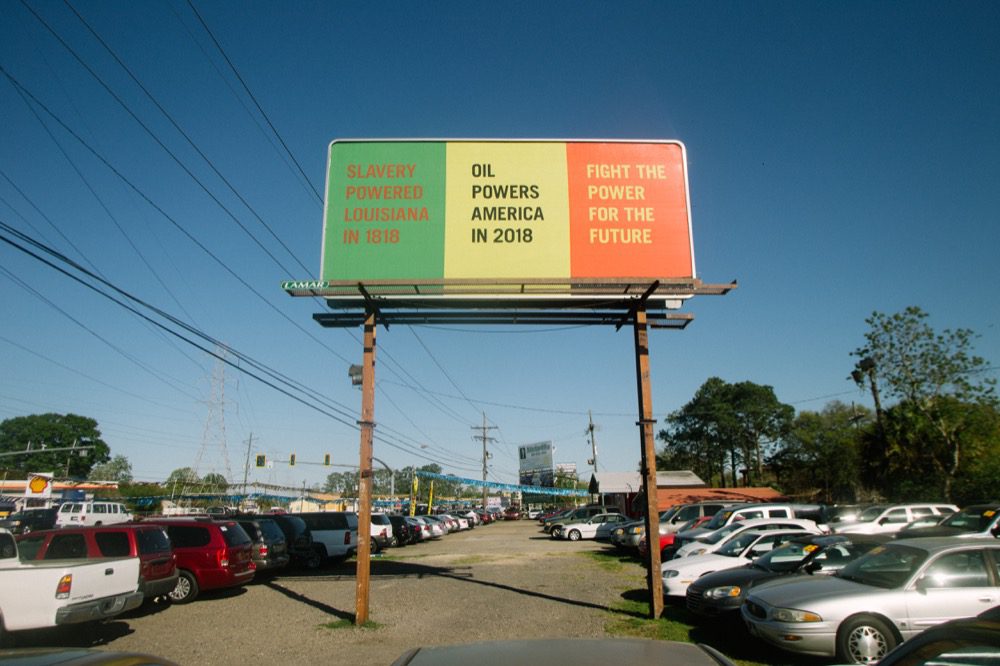
A Fossil Free Fest billboard by artist Dread Scott in Laplace, Louisiana. Courtesy Fossil Free Fest. Photo by Patrick Melon.
Compared to Europe, the United States government barely funds the arts at all. Arts organizations get almost every dime from corporate giving, private foundations, or private citizens. A lot of Louisiana’s wealthiest people made their fortunes in oil and gas. Where can an arts institution go if it can’t go to fossil fuels? And what does fossil-fuel divestment mean—refusing to accept corporate sponsorship, donations from oil and gas industry foundations, and individual gifts; purging investment portfolios; or all of the above?
Fossil Free Fest presented one project that may have found a way forward: Beka Economopoulos’ Natural History Museum, a group of artists and activists who pose as a natural-history museum at museum conferences (they are registered with the American Alliance of Museums and the Association of Science-Technology Centers), presenting mock natural-history exhibits that highlight climate change, pollution, and elements of science that museums have sometimes left out, allegedly to please wealthy donors. At museum-insider spaces like conferences, the group was able to speak directly to museum professionals and eventually build up enough pressure to cause David H. Koch to resign from the board of the American Natural History Museum in New York in 2016, proving that some of the most effective pressure can come from within. But Koch contributed over $20 million during his tenure on the board, and losing him is a significant financial loss for the museum (both Koch and the museum deny actions by activists contributed to Koch’s resignation).
Brown proposed another idea: for arts organizations to band together, raising money as a group from non-fossil fuel sources. She called it a fossil-free super PAC. Antenna, the host of Fossil Free Fest, is committed to divestment, which means not seeking oil-industry funding in the future. The Joan Mitchell Center is considering divestment, although it is in a different situation than most arts organizations. The Joan Mitchell Center is a fully-funded program of the Joan Mitchell Foundation, so they don’t fundraise. According to Center director Gia Hamilton, divestment for the Joan Mitchell Foundation would mean looking at their investment portfolio and deciding whether it aligns with their values.
In 2015, New Orleans Airlift took $50,000 from the Helis Foundation for their Roving Music Box Village. Artistic Director Delaney Martin says that Airlift was offered and accepted funding from Helis and understood that many of the other, larger arts organizations in town were receiving significant funding from the foundation. She claims she was not aware at the time that it was connected to an oil company. The decision sparked a conversation about ethical fundraising within Airlift, and they have not taken Helis money since. But she also makes an interesting point about the local funding landscape, “Who else [other than the Helis Foundation] is restoring Enrique Alférez sculptures?” Or Lynda Benglis sculptures?
So far, smaller arts organizations and initiatives, like Airlift and others who attended Fossil Free Fest, are leading the charge for divestment. They have smaller budgets and less space to fill if they lose fossil-fuel money. But in order to put pressure on the industry, collective action is necessary, and larger organizations will have to stand with the smaller ones. I reached out to the Ogden Museum, the New Orleans Museum of Art, and the Contemporary Arts Center for comment, and none of these museums said they are currently considering purging investment portfolios of fossil-fuel assets or refusing funding from fossil-fuel companies or related foundations.



